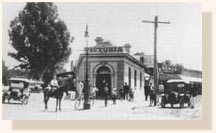 Court House Court House
Gaol
Maldon Hospital
Museum
Post Office
Primary School
Court House

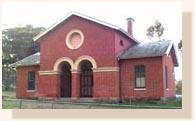 A timber courthouse was constructed in 1857 but
when it was completed the timber fittings were found to be
too large for the building and did not leave room for the
public. A new brick courthouse was designed by Kawerau and
was completed in 1861 at a cost of 2,016. Problems with the
quality of the construction included changing the bricks
used from Castlemaine bricks to ones produced by Maldon's
Wagners Brick Works. The courthouse was closed in 1968.
A timber courthouse was constructed in 1857 but
when it was completed the timber fittings were found to be
too large for the building and did not leave room for the
public. A new brick courthouse was designed by Kawerau and
was completed in 1861 at a cost of 2,016. Problems with the
quality of the construction included changing the bricks
used from Castlemaine bricks to ones produced by Maldon's
Wagners Brick Works. The courthouse was closed in 1968.
Gaol

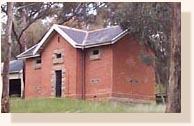 The brick lock-up was constructed in 1864 at a cost of 490 and is located in the
Police Reserve.
The brick lock-up was constructed in 1864 at a cost of 490 and is located in the
Police Reserve.
Hospital

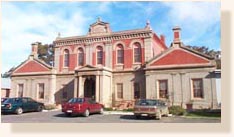 The hospital was designed by D R Drape and the
two wards were built in 1859, enclosed by verandahs. The
central section was added at a later date.
The hospital was designed by D R Drape and the
two wards were built in 1859, enclosed by verandahs. The
central section was added at a later date.
Museum

The erection of the Market Hall in 1859 was one of the earliest projects
of the Borough Council. The building was designed by Hartley
and was built in red brick. The Market closed in 1860 and
the building was then used as the Shire Hall until 1964.
Since its original construction, a porch has been added,
hammer beamed arches were used to tie the walls together and
internal walls were added. The Hall is now used as the
Maldon Museum.
Post Office

The first Post Office was opened in 1854 in a tent, this
moved to a store in Long gully road in 1855 and then a store
in Main street in 1857. Branch offices were opened at Eagle
Hawk and Porcupine Flat in 1861. The existing Post Office
was completed in 1870 with alterations being made in 1908 to
house the new telephone exchange. In 1880 Mary Richardson
was appointed as Maldon's first postmistress. Her daughter
Ethel later became famous as the writer Henry Handel
Richardson.
Primary School

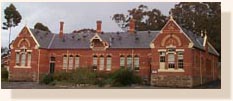 Prior to the opening of the school, education
was provided by a number of private schools and churches.
The building's construction is brick on a base of local
ragstone and was completed in 1875. The school was designed
to accommodate 750 pupils but the largest number of students
attending the school was 640 in the 1890's.
Prior to the opening of the school, education
was provided by a number of private schools and churches.
The building's construction is brick on a base of local
ragstone and was completed in 1875. The school was designed
to accommodate 750 pupils but the largest number of students
attending the school was 640 in the 1890's.
|